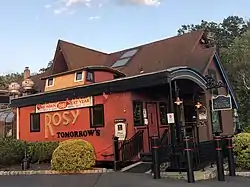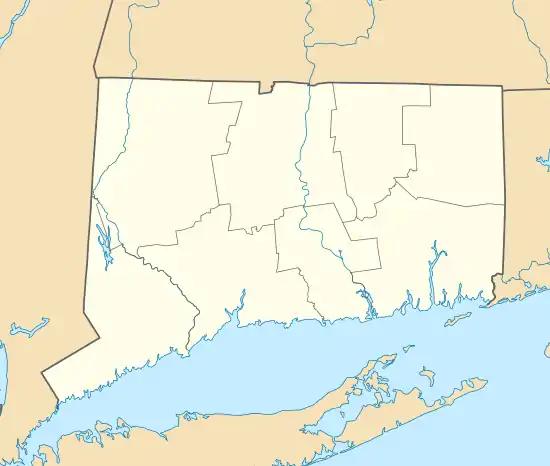Mill Plain, Connecticut | |
|---|---|
 Rosy Tomorrow’s, Old Mill Plain Rd | |
 Mill Plain Location in Connecticut  Mill Plain Location in the United States | |
| Coordinates: 41°23′42.34″N 73°30′56.45″W / 41.3950944°N 73.5156806°W[1] | |
| Country | |
| U.S. state | |
| County | Fairfield |
| Region | Western CT |
| City | Danbury |
| Major highways | |
Mill Plain is an unincorporated area in the City of Danbury, Connecticut, United States.[1] It is located in the westernmost part of the city, bordering the town of Southeast, New York.
History

Defined as a village in the western part of Danbury,[2] Mill Plain has also historically been considered a semi-autonomous hamlet.[3] The first home in the area was built around 1720 by Nathaniel Stevens.[4][5] By 1725 Samuel Castle had built his second grist mill, located in this section of town, which gave rise to the name Mill Plain.[6] An early mention of Mill Plain is found in a 1769 deed for 20 acres (8.1 ha) of land near a stream "that runs into ye Mill Plain Pond," which is the original name for Lake Kenosia. The area belonged to the town of Ridgefield at that time.[7]
In 1865, resident Henry M. Senior opened a general store and post office. Five years later, Senior built a hat manufacturing shop in the area, which operated until 1892.[8] Mill Plain station, was built in 1881, and closed in 1928 after being acquired by the New York, New Haven and Hartford Railroad.[9] The post office was operated by the Senior family until the 1940s.[10]
Parks and recreation
- Richter Park
- Farrington Woods
- Lake Kenosia Park
Notable people
Marian Anderson (1897-1993)[11]
References
- 1 2 "Mill Plain". Geographic Names Information System. United States Geological Survey, United States Department of the Interior.
- ↑ Gannett, Henry (1894). "A Geographic Dictionary of Connecticut" (PDF). 117: 40. doi:10.3133/b117. hdl:2346/64184. Retrieved February 22, 2022.
{{cite journal}}: Cite journal requires|journal=(help) - ↑ Devlin, William E. (2013). Danbury's Third Century: From Urban Status to Tri-Centennial.
- ↑ Bailey, James M. (1896). History of Danbury, Conn., 1684-1896.
- ↑ Stevens, Frederick (1891). Genealogy of the Stevens family, from 1635 to 1891.
- ↑ Devlin, William (1984). We Crown Them All: An Illustrated History of Danbury. Woodland Hills, California: Windsor Publications. p. 11. ISBN 0-89781-092-9.
- ↑ Sanders, Jack (August 30, 2021). "The Ridgefield Encyclopedia" (PDF). Ridgefieldlibrary.org. Ridgefield Library. Retrieved February 22, 2022.
- ↑ Beers, J. H. (1899). Commemorative Biographical Record of Fairfield County, Connecticut.
- ↑ Danbury Railway Museum. "Mill Plain station". Danburyrail.org. Danbury Railway Museum. Retrieved February 21, 2022.
- ↑ "Mill Plain Post Office May Be Discontinued, No One Wants Job". Hartford Courant. Associated Press. January 20, 1940. Retrieved February 14, 2022.
- ↑ "Marian Anderson History". Western Connecticut State University. Retrieved February 17, 2022.

.jpg.webp)



